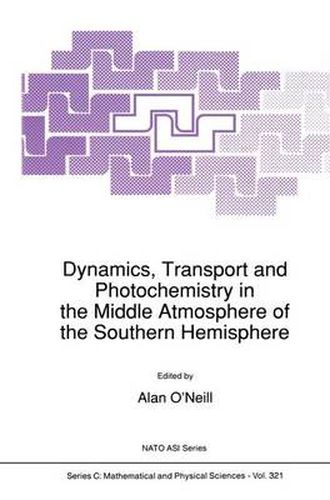Readings Newsletter
Become a Readings Member to make your shopping experience even easier.
Sign in or sign up for free!
You’re not far away from qualifying for FREE standard shipping within Australia
You’ve qualified for FREE standard shipping within Australia
The cart is loading…






This title is printed to order. This book may have been self-published. If so, we cannot guarantee the quality of the content. In the main most books will have gone through the editing process however some may not. We therefore suggest that you be aware of this before ordering this book. If in doubt check either the author or publisher’s details as we are unable to accept any returns unless they are faulty. Please contact us if you have any questions.
The NATO Advanced Research Workshop on Dynamics, Transport am. Photochemistry in the Middle Atmosphere of the Southern Hemisphere was held in San Francisco, California, U.S.A., 15-17 April 1989. In addition to NATO, the workshop was supported by the University of California, Los Angeles, and by the National Aeronautics and Space Administration, U.S.A. (NASA). The American Meteorological Society was a co-operating organization. The venue for the workshop was the Lone Mountain Conference Center of the University of San Francisco. The workshop was organized and directed by Dr A.O'Neill (Hadley Centre for Climate Prediction and Research, Meteorological Office, Bracknell, U.K.) and Prof C.R. Mechoso (Dept of Atmospheric Sciences, University of California, Los Angeles, U.S.A.). The workshop was the third one held as part of the Middle Atmosphere in the Southern Hemisphere (MASH) project, an international effort (under the auspices of the Middle Atmosphere Program) to learn more about dynamics, transport and photochemistry in the middle atmosphere of the southern hemisphere. Before the discovery that, during recent years, a dramatic thinning of the ozone layer takes place over Antarctica in spring - the ozone hole - the middle atmosphere of the southern hemisphere had received much less attention than that of the northern hemisphere from meteorologists and atmospheric chemists. The MASH project was instituted to remedy this comparative lack of interest.
$9.00 standard shipping within Australia
FREE standard shipping within Australia for orders over $100.00
Express & International shipping calculated at checkout
This title is printed to order. This book may have been self-published. If so, we cannot guarantee the quality of the content. In the main most books will have gone through the editing process however some may not. We therefore suggest that you be aware of this before ordering this book. If in doubt check either the author or publisher’s details as we are unable to accept any returns unless they are faulty. Please contact us if you have any questions.
The NATO Advanced Research Workshop on Dynamics, Transport am. Photochemistry in the Middle Atmosphere of the Southern Hemisphere was held in San Francisco, California, U.S.A., 15-17 April 1989. In addition to NATO, the workshop was supported by the University of California, Los Angeles, and by the National Aeronautics and Space Administration, U.S.A. (NASA). The American Meteorological Society was a co-operating organization. The venue for the workshop was the Lone Mountain Conference Center of the University of San Francisco. The workshop was organized and directed by Dr A.O'Neill (Hadley Centre for Climate Prediction and Research, Meteorological Office, Bracknell, U.K.) and Prof C.R. Mechoso (Dept of Atmospheric Sciences, University of California, Los Angeles, U.S.A.). The workshop was the third one held as part of the Middle Atmosphere in the Southern Hemisphere (MASH) project, an international effort (under the auspices of the Middle Atmosphere Program) to learn more about dynamics, transport and photochemistry in the middle atmosphere of the southern hemisphere. Before the discovery that, during recent years, a dramatic thinning of the ozone layer takes place over Antarctica in spring - the ozone hole - the middle atmosphere of the southern hemisphere had received much less attention than that of the northern hemisphere from meteorologists and atmospheric chemists. The MASH project was instituted to remedy this comparative lack of interest.